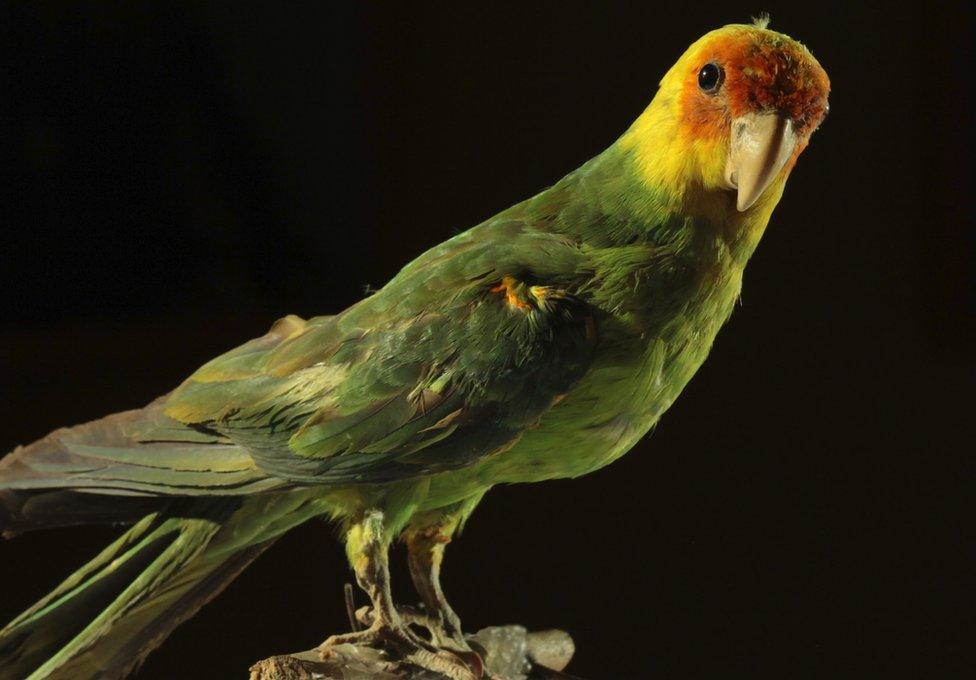Humans 'sole culprits' in US parrot extinction
- Published

The genome comes from a specimen held in a private collection in Spain
A genetic study of the US's only native parrot appears to confirm its extinction was down to humans alone.
Scientists sequenced the genome of a stuffed Carolina parakeet held in a private collection.
The colourful bird's DNA showed none of the signs of inbreeding characteristic of animals that have been in decline for many years.
Instead, its genetic sequence suggests populations were buoyant until the expansion of European settlers.
The parrots then disappeared abruptly, with the last captive specimen dying in Cincinnati Zoo on 21 February 1918. The bird was once found from New England in the east to Colorado in the west.
The bird had green plumage with a yellow head, and measured about 13ins (33cm) long. They lived in old-growth forests along rivers and in swamps.
Carolina parakeets in a plate from John James Audubon's The Birds of America, published in sections between 1827 and 1838
"Many endangered species have been sequenced and what seems to be a pattern is that when populations are small and declining for a long period of time, this leaves some signals in their genomes that can be recognised," co-author Carles Lalueza-Fox, from the University of Barcelona, explained.
"Even if you have a single specimen, as here, we have a genome from the father and a genome from the mother; two copies of each chromosome. If the population has been small for thousands of years, these two copies will be very similar to each other and over long stretches sometimes they will be identical."
When a population is large, Dr Lalueza-Fox explained, the two chromosome copies will be more different genetically. Indeed, this is exactly what the team saw in the Carolina parakeet (Conuropsis carolinensis).
"The inference is that this bird was not subjected to a very long demographic decline for thousands of years, it was something very quick," the University of Barcelona geneticist explained.
Spanish TV journalist Pere Renom with Carles Lalueza-Fox. The process of extracting and analysing the bird's genome was filmed for a documentary in Spain
Dr Lalueza-Fox noted that the extinct bird's closest living relative, the Sun parakeet (Aratinga solstitialis), which is native to South America, has much less genetic variation.
The precise mechanism of the Carolina parakeet's extinction remains mysterious, however.
Deforestation, along with hunting and trapping, must both have played roles in its demise. Disease and even competition with non-native honeybees may also have been factors.
The birds congregated in large, noisy flocks and were gregarious in their behaviour. Contemporary observers noted that they would return to the locations of dead or dying birds, which made the wholesale slaughter of flocks even easier for hunters.
The American naturalist John James Audubon had commented on the birds' declining numbers in 1832. The birds had disappeared from the wild by the early 20th Century.
A Carolina parakeet is shown in an engraving from the late 18th Century
The researchers also found signs of a genetic adaptation to the bird's toxic diet. The Carolina parakeet had a liking for eating cockleburs, a coarse flowering plant that contains a powerful toxin called carboxyatractyloside.
The toxin accumulated in the bird's tissues, and there are records of cats that ate Carolina parakeets being found dead.
The researchers uncovered genetic changes in two proteins known to interact with carboxyatractyloside that could underlie a dietary adaptation to the poison.
The birds are one target for de-extinction, the scientific discipline which seeks to bring lost species back from the dead.
One approach might be to take the Sun parakeet, and use genome editing to modify its DNA code to look like its extinct relative. But despite the similarities between the two species, this will be far from straightforward.
Hundreds of specimens of the extinct bird remain in museums
"If we compare both genomes, we can easily see there is a list of several hundred protein coding genes that have changes, that also seem to be functionally important," Prof Lalueza-Fox told 成人快手 News.
"It's an enormous task. But even if we wanted to do that, as far as I know, nobody has been able to clone a bird... nobody knows how to modify something before it becomes an egg.
"If anything, this genome illustrates the enormous difficulties behind the de-extinction ideas. I am not saying it's impossible, but it is incredibly difficult."
The last captive Carolina parakeet died in the same cage that the last passenger pigeon had died in four years earlier. The decline of both birds parallels the .
The genome-sequencing project began when a journalist discovered a specimen was held in a private collection in Espinelves, North-Eastern Spain. The stuffed bird had been acquired by an ancestor of the current owners.
The study has been
Follow Paul